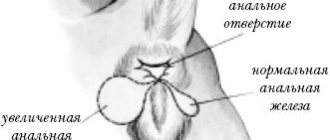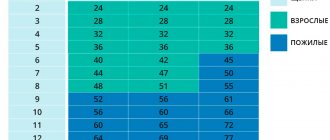Any form of dog behavior has its own motivation. Many people are familiar with the situation when a dog chases its tail, and, having grabbed it, begins to torment and gnaw at it. What explains this rush? There can be quite a few reasons and not all of them are harmless. In some cases, such behavior indicates that the dog is seriously ill, which means he needs veterinary care. The pathology is called “caught-tail syndrome.” From this article you will learn why your dog behaves this way and how to wean it from this bad habit.
Instinct
Many dogs first walk in circles and only then go to bed. And this is a completely natural behavior that probably comes from their ancestors. After all, once upon a time, undomesticated dogs were forced to spend the night on the street and sleep without relying on outside warmth. Therefore, the dog prepared its sleeping place by trampling leaves or snow around it before going to bed.
It is also possible that the dog also does this because he wants to be more aware of objects and dangers around him, because this allows him to look around and assess whether there are enemies nearby (such as snakes, for example).
Chasing the tail
Another common reason why dogs circle around themselves is to chase their own tail. This “cutting circles” around can be explained in different ways. For example, puppies often chase and chew their tails when they are trying to learn more about their bodies. Other dogs may chase their tails simply because it elicits a positive response from their owners.
Water scarcity on Earth is increasing: March 22 is World Water Day
Coincidentally or not: why Lady Di put a necklace on her head, which upset the queen
“Creativity and Creativity”: Rosobrnadzor is thinking about transforming the Unified State Exam
Dogs who are stuck at home can chase their own tail for fun and exercise. But behind this behavior there may also be a dangerous illness that needs to be treated. These could be skin diseases, problems with the anal glands, various parasites or all sorts of other inconveniences that cause the dog to circle around itself in an attempt to reach the place that is causing concern.
Help from specialists
The unwanted behavior itself can be removed, but this will not affect the psychological decision. Moreover, it is difficult to perform a stereotypical action without anxiety. The important thing here is not to scold the dog, but to understand what factor provokes negative behavior and remove it. It is important for a pet to understand that it is the owner who must control its behavior. Simply put, learn new movements.
Initially, the dog is taught well-known commands. First, this is done in the absence of stimuli, and then, when she has completely calmed down and adapted, they are gradually introduced. At first this is done in a weakened form, while the degree of irritability increases each time. For example, if your pet is annoyed by a ringing call, then you should record its sound on your phone and turn it on quietly.
It is important not to rush things here, because when unwanted behavior occurs, it is important to pause the training and take a few steps back. To improve the result, it is important not only to constantly praise the dog, but also to treat it with treats. The dog handler himself draws up a schedule for the exercises and determines when to move on to the next stage. The training process can last from several weeks to a month.
In parallel with training, veterinarians recommend that the dog take a course of medications. Surely many had no idea that a pet’s innocent play with its tail can signal serious problems that owners should definitely pay attention to.
Anxiety
Dogs that are bored, stressed, overstimulated, or simply lacking mental and physical stimulation may also become dizzy.
Additionally, dogs that are kept in cages or pens for too long may begin circling the perimeter as if possessed and may even continue to do so after being released into the wild.
Sometimes this behavior can indicate obsessive-compulsive disorder. A dog suffering from separation anxiety may chase its tail in the same way that a nervous person bites their nails. Another dog may chase its tail when it is excited by the presence of a visitor, animal or bird in the yard. You may need the help of a veterinarian or behaviorist to help your dog overcome its problems.
Mental disorders
In other cases, regular tail racing is a pathology, and genetically determined . We are talking about a mental disorder that can be diagnosed at a fairly early age. Unfortunately, in this case it is impossible to stop the dog from chasing its tail. The behavior can be partially corrected with sedatives and training, but it cannot be stopped completely.
Important! Dogs with mental disorders are excluded from breeding, no matter what breeding value they may have. If a dog is chasing its tail and the reason for this is mental, the disorder will be passed on to future generations.
The difficulty is that mental disorders manifest themselves to a full extent in puppies older than 3 months, that is, after moving to a new home. The owner thinks that the baby is just playing and ignoring the problem. The second difficulty is the lack of warnings about this problem. For years people have treated Tail Forecast as a game or a feature. Today, mental abnormalities are detected immediately only if the puppy lives with experienced owners who are constantly improving their knowledge.
The root of the problem is that obsessive mental states have not been recognized as a separate diagnosis for a long time. This area has not attracted the attention of veterinarians and dog handlers, and therefore remains poorly studied to this day. Tail chasing is not the only genetic disorder that has been ignored and passed on to subsequent generations of breeding dogs. For example, some animals often click their jaws, the reason for this is genetics, and not a disease of the eyes or central nervous system, as previously thought.
Read also: Why does Russia need a war in Syria?
The problem is aggravated by the fact that a veterinarian and a behavior correction specialist (animal psychologist, animal psychotherapist) are completely different fields. There are very few specialists who study and treat the psyche of animals, and among those who practice there are many (to put it mildly) charlatans. It is also interesting that experts did not link the symptoms into a single scheme. Today, no one argues that the combination of two or more symptoms from the list below indicates a mental disorder in the dog:
- Clicking jaws.
- Running in a circle (around its axis) behind the tail or without trying to catch it.
- Obsessive licking and sucking of areas of the body, especially the paws.
- Gnawing fur looks like a dog catching fleas that are not there.
- Eating inedible things, including feces.
- Uncontrollable or unpredictable aggression.
- Aggression of males towards females.
Important! If your dog is exhibiting one or more symptoms, you are dealing with a serious problem. To help inexperienced owners, you will need to consult a veterinarian and (!) a dog handler or an experienced zoopsychologist.
Neurological problems
There are many medical conditions that can cause a dog to want to circle around, and some of them are neurological in origin. Tumors, head injuries, strokes and seizures can damage the brain and lead to uncoordinated gait and circling.
Appetizing cakes with a creamy texture in the form of cute flowers
Malaysian artist creates stunning surreal photo illusions
They Can't Chew: Things That Are Very Difficult for Cats to Do
Additionally, some dogs (especially older ones) may have cognitive dysfunction—a version of Alzheimer's. Cognitive dysfunction in dogs can occur for a number of reasons, such as the accumulation of abnormal proteins in the brain. This creates a buildup of plaque, which eventually damages nerves and leads to loss of brain function. This damage can cause the dog to have poor spatial awareness or to walk in circles.
When the behavior is neurological in origin, dogs usually circle in only one direction and it is very difficult (or impossible) to get them to stop and turn in the other direction. Additionally, their eyes may have trouble focusing or appear abnormally wide. Therefore, if your dog exhibits any of these symptoms, it is important to take him to the vet immediately.
What should the owner do?
Of course, a dog owner can help his pet, and this should definitely be done. The owner’s actions directly depend on what specific reason provokes this behavior of the dog:
- psychological aspects - try to devote enough time to your pet. Walk with him regularly and play. Eliminate external factors that may disturb the dog. This could be, for example, third parties, other animals, children who do not always understand what they are doing with the dog;
- ticks, fleas, etc. – carefully examine the dog’s anal area. If you see a tick or fleas running around, it means you need to fight them. The ticks are removed very carefully so as not to leave the head in the wound. Fleas can be eliminated using appropriate shampoos or collars;
- worms - you will need to do an analysis that will help determine the type of parasite and prescribe adequate treatment. To avoid re-infection, you will need to give your animal deworming medications from time to time as a preventative measure;
- inflammation of the paraanal glands - you can clean them yourself, the veterinarian will tell you how to do this. And for the first time you should always contact a specialist, and the sooner the better;
- allergies – protect your pet from the allergen. We will have to find out what exactly provokes an allergic response from the animal’s body;
- skin diseases - contact your veterinarian, who will determine the type of disease and prescribe appropriate treatment.
Infections
Ear infections are a common cause of circling in dogs, and deep or persistent infections are usually the most worrisome. Severe cases are very dangerous and can lead to deafness, facial paralysis, vestibular disorders such as head tilting, circling and lack of coordination. Symptoms of a typical ear infection include head shaking, foul odor, and swelling. Therefore, it is important to regularly check your dog's ears for any of these signs and seek treatment from your veterinarian.
Traveling around Russia and saving: how to get some money back for your trip
Emigration to the USA and an unsuccessful marriage: how the life of the beauty Natalia Lapina turned out
Dresses of Maria Feodorovna and more: The Hermitage made a gift to the Historical Museum
Additionally, there are many other infections that can cause a dog to walk in circles. Any of these that affect the brain or nervous system can cause loss of coordination. For example, pets with canine distemper may experience circling, head tilting, muscle spasms, spasms with chewing movements of the jaw, and drooling. Therefore, it is important to get your dog vaccinated and contact your veterinarian immediately at the first sign of illness.
Diagnostics
To identify the cause of the disease, diagnostics will be required, which will include a number of measures:
- visual inspection of the places that the dog combs, as well as for the presence of parasites in the fur;
- blood test to detect the presence of allergies;
- scraping from damaged areas to detect microorganisms.
Important! After the diagnosis, the veterinarian, if necessary, prescribes treatment and suggests why and what the owners should do to correct the situation.
You should not diagnose the problem yourself, because such a solution can harm the health of the animal.
Vestibular disease
Vestibular disease is another common cause of dogs pacing, especially if they are older. Vestibular problems can also cause head tilt, loss of coordination, nausea and vomiting. Symptoms can occur spontaneously, and veterinarians are often unable to pinpoint their source.
Fortunately, vestibular disease often resolves with supportive care. Make sure your dog eats and drinks well, and make sure he doesn't lose his balance in dangerous areas. But it's still important to visit your veterinarian because anxiety tends to develop into more serious consequences, such as a stroke or brain tumor.
Pain
Dogs in pain may circle around themselves excessively, especially when they lie down to rest, simply because they are trying to find a better body position in which the pain is not as severe. You need to observe your pet to see if he is having trouble lying down and falling asleep. If your dog is frequently anxious, he should be taken to the vet to treat the pain and get a proper diagnosis.
In theory, any medical condition can make a dog quite restless when chasing its tail. But there are still common signs of this behavior - arthritis or pain in their body. Plus, some dogs may circle due to gastrointestinal issues, which also cause pain and discomfort. Bloating is especially life-threatening. Therefore, it is important to monitor the behavior of your pets to be sure that nothing bad happens to them.
Found a violation? Report content
Does this behavior depend on the breed?
Why does a cat bite its owner’s legs: when you stroke it and for no reason
Any dog can play with its tail for a short time. If he doesn't constantly return to this activity, there's no need to worry.
Manifestation of the syndrome in a pet
Some breeds are more susceptible to a disorder called caught-tail syndrome:
- German Shepherd;
- bull terrier;
- collie;
- Jack Russell Terrier.
Note! The disease becomes noticeable at an early age. And such pets are not recommended for breeding, since there is a high risk that the syndrome will be passed on to offspring.











